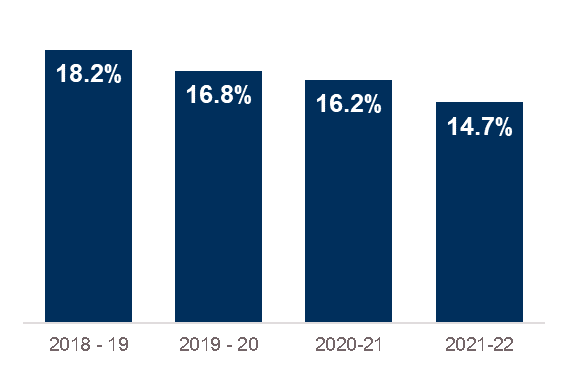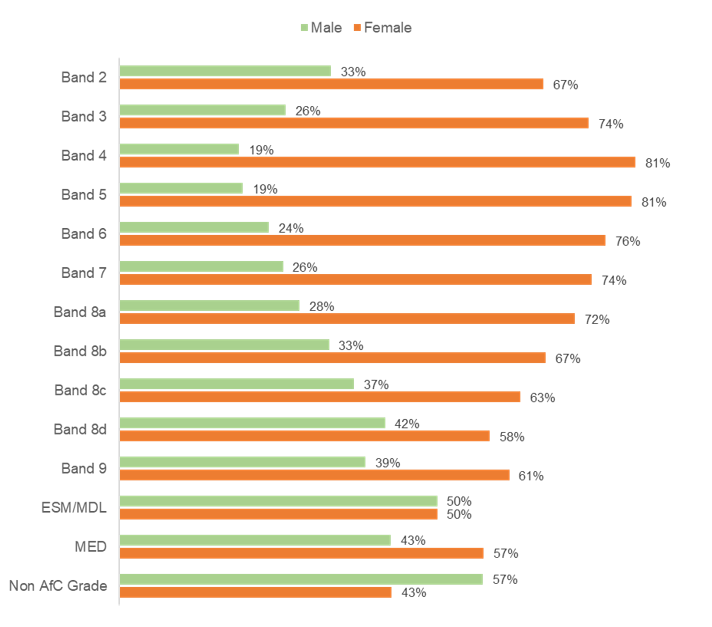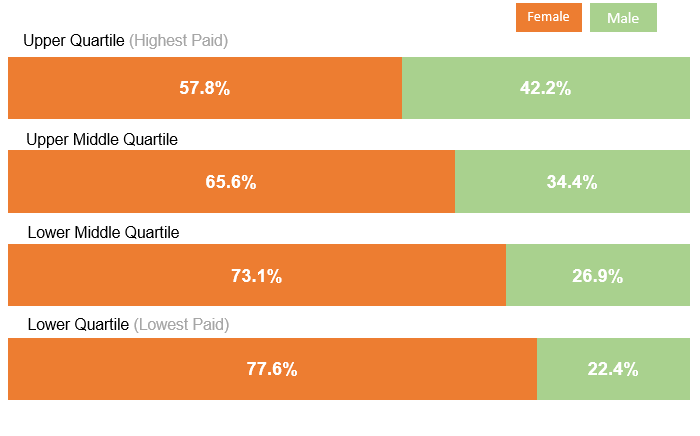Classification: Official
Publication reference: PRN00360
1. Introduction
Organisations with 250 or more employees are mandated by the government to report annually on their gender pay gap. The requirements of the mandate within the Equality Act 2010 (Gender Pay Gap Information) Regulations 2017 are to publish information relating to pay for six specific measures, as detailed in this report.
The intention of the pay gap reporting is to focus organisational attention on taking action to reduce those inequalities, bringing to life our commitments from the People Promise and focus effort on improving staff experiences within our workplace, improving retention and making the NHS the best place to work. Evidence indicates that disparity in pay has a lasting socioeconomic impact on staff.
This gender pay gap report is a snapshot as of 31 March 2022. At that time the organisation remained as two separate entities – NHS England and NHS Improvement. On this basis, the report gives an overview of the gender pay gap on both organisational performances.
As of 31 March 2022, NHS England and NHS Improvement employed a combined total of 11,449 colleagues. For the purposes of this report, we are using electronic staff record (ESR) data to undertake this analysis, and therefore we are dependent on staff reporting their protected characteristics on ESR (via ESR self service).
2. What is our gender pay gap?
The gender pay gap reporting is based on the government’s methodology for calculating difference in pay between female and male employees, considering full-pay relevant employees of NHS England and NHS Improvement.
‘Equal pay’ means being paid equally for the same/similar work. ‘Pay gap’ is the difference in the average pay between two groups.
As of 31 March 2022, NHS England and NHS Improvement’s 11,449 employees comprised 68.7% women and 31.3% men. This was an increase of 0.9% more women in the organisation as a whole, compared to the previous year.
The gender pay gap trend for NHS England and NHS Improvement is positive, with improvements made from the previous year. The mean gender pay gap was 14.7% in March 2022, representing a reduction in the gap of 1.5% percentage points. The median gender pay gap has remained at 14.0% in March 2022, equating to no change in percentage points since March 2021.
Figure 1: Gender pay gap data – mean average (2018-22)

Image description:
A bar graph with four columns representing the annual periods of 2018 to 2019, 2019 to 2020, 2020 to 2021 and 2021 to 2022. The graph shows the mean average gender pay gap declining year on year, from 18.2% in 2018 to 2019, 16.8% in 2019 to 2020, 16.2% in 2020 to 2021, and 14.7% in 2021 to 2022.
Overall, in NHS England and NHS Improvement, women occupied 57.8% of the highest paid jobs and 77.6% of the lowest paid jobs. Men occupied 42.2% of the highest paid jobs and 22.4% of the lowest paid jobs.
A significant driver for the pay gap is having a smaller proportion of men in lower pay bands related to their share of the overall population (see Section 4). Although the mean salaries for women across pay bands 2 to 7 were higher, their mean earnings were considerably less than men across bands 8b and above. Similarly, we had the highest proportion of women within pay bands 7, 8a and 8b compared with the men among whom we had more between bands 7 and 8d.
Reducing our gender pay gap implies increasing the proportion of men in the organisation and continuing the focus on creating pay equity across pay bands.
3. What is the bonus gender pay gap?
Since their inception, NHS England and NHS Improvement have had no scope for bonus payments within the Agenda for Change terms and conditions of service.
3.1 Clinical Excellence Awards
As an organisation we do honour existing Clinical Excellence Awards (CEAs) payments, which are recognised practice across the NHS. CEAs are nationally recognised discretionary payments that are rewarded to clinical colleagues who have contributed exceptional clinical skills and expertise to improve the quality of care in the NHS. The CEAs are awarded to attract and retain highly skilled clinical colleagues within the NHS.
The combined mean gender pay gap for CEA payments in NHS England and NHS improvement was 39.5% and the median gender pay gap for CEA payments was 60%.
This represented an improvement in our bonus gender pay gap from March 2021 to March 2022, where the mean gap for CEA payments was 76.3% and the median 66.7%
We will continue to deliver initiatives that seek to continue or increase the improvement trajectory seen to date.
4. What is the proportion of men and women in each pay quartile?
Overall, in NHS England and NHS Improvement, women occupied 57.8% of the highest paid jobs (upper quartile). The national population of women in England and Wales is 51%. However, most (77.6%) employees in NHS England and NHS Improvement in lower quartile (lowest paid) jobs were women, reflecting that male employees were more highly represented in higher paid jobs.
Comparing these quartiles suggests the lower proportion of men in lower pay bands relative to their share of the population (31.3%) was a key driver of the gender pay gap in NHS England.
Figure 2 shows the proportion of males and females in each pay band (males are represented in green and females in orange).
Figure 2: Proportion of men and women in each pay quartile (March 2022)
Image description:
A graph showing the proportion of men and women in each pay quartile. The graph shows that female representation reduces moving up each quartile:
- The upper quartile of the highest paid staff is 57.8% female and 42.2% male.
- The upper middle quartile is 65.6% female and 34.4% male.
- The lower middle quartile is 73.1% female and 26.9% male.
- The lower quartile of the lowest paid staff is 77.6% female and 22.4% male.
Figure 3: Gender breakdown by pay band (March 2022)

Image description:
A graph showing the gender breakdown by pay band:
- Band 2 is 67% female and 33% male.
- Band 3 is 74% female and 26% male.
- Band 4 is 81% female and 19% male.
- Band 5 is 81% female and 19% male.
- Band 6 is 76% female and 24% male.
- Band 7 is 74% female and 26% male.
- Band 8a is 72% female and 28% male.
- Band 8b is 67% female and 33% male.
- Band 8c is 63% female and 37% male.
- Band 8d is 58% female and 42% male.
- Band 9 is 61% female and 39% male.
- Band ESM/MDL is 50% female and 50% male.
- Band MED is 57% female and 43% male.
- Non AfC grade is 43% female and 57% male.
5. Addressing the gender pay gap
We aim to continue to reduce our gender pay gap year on year, with the intention to create greater equality in our pay framework.
Reducing our gender pay gap implies increasing the proportion of men in the organisation and continuing the focus on creating pay equity across pay bands.
Effective policies for closing the gender pay gap seek to address factors and barriers common to all women (such as the number in lower-grade jobs with lower pay) as well as target inequalities faced by women belonging to specific groups, based on characteristics such as ethnicity, age and profession.
We have implemented a number of actions over the last two years that have contributed to reducing our gender pay gap:
- expanding our inclusive approaches to recruitment and talent management by implementing an internal expression of interest process, allowing colleagues streamlined access to career progression opportunities via a simplified application process
- redefining options of ‘how and where we work’, linked to Our Ways of Delivery, which provides colleagues with greater flexibility to carry out their role while managing their personal commitments at home
- promoting and updating our flexible working policy and supportive guidance to help colleagues achieve work-life balance
- investment in our staff networks, particularly women’s and the male networks; helping to place a spotlight and develop interventions for the key issues that are important to our members.
We propose to take further action in the forthcoming year to reduce our pay gap by:
- continuing to develop talent management strategies that focus on supporting our female colleagues through their career journey in the organisation
- continuing to work with all staff networks to take an intersectional approach to identifying collaborative actions that will support pay equality
- developing management guidance and resources to upskill line managers on inclusive people practices
- refining inclusive recruitment practices through the organisational change programme and beyond; building on existing strategy, tools, resources and local promotion and recruitment practices to engage and employ applicants and retain employees from all communities.
6. Definitions, assumptions and scope
All employee data in this report is extracted from the NHS England and NHS Improvement ESR system, showing a snapshot as of 31 March 2022. The reporting period covers 1 April 2021 to 31 March 2022. Hourly rate is calculated using base pay, allowances and bonus pay (where applicable).
Table 1: Definitions
|
Key word |
Definition |
| Pay gap | Difference in the average pay between two groups. |
| Mean gap | Difference between the mean hourly rate for female and male employees. Mean is the sum of the values divided by the number of values. |
| Median gap | Difference between the median hourly rate of pay for female and male employees. Median is the middle value in a sorted list of values. It is the middle value of the pay distribution, such that 50% of employees earn more than the median and 50% earn less than the median. |
| Mean bonus gap | Difference between the mean bonus paid to female and male employees. Mean is the sum of the values divided by the number of values. |
| Median bonus gap | Difference between the median bonus pay paid to female and male employees. Median is the middle value in a sorted list of values. It is the middle value of the bonus pay distribution, such that 50% of employees earn more than the median and 50% earn less than the median. |
| Bonus proportions | Proportions of female employees who were paid a bonus, and the proportions of male employees who were paid a bonus. |
| Quartile pay bands | Proportions of female and male employees in the lower, lower middle, upper middle and upper quartile pay bands. Quartile is the value that divides a list of numbers into quartiles. |
| Equal pay | Being paid equally for the same/similar work. |


